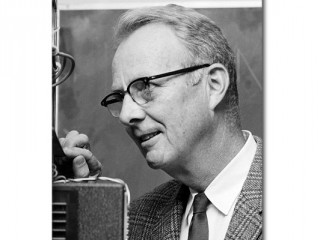
Luis W. Alvarez biography
Date of birth : 1911-06-13
Date of death : 1988-09-01
Birthplace : San Francisco, California, U.S.
Nationality : American
Category : Science and Technology
Last modified : 2011-09-28
Credited as : physicist, K-electron,
1 votes so far
Returning to Berkeley after the war, he designed and oversaw construction of the first proton linear accelerator, completed in 1947. In 1951 he proposed charge exchange acceleration, which led to construction of the first Tandem Van de Graaf accelerator and a 72-inch liquid hydrogen bubble chamber, much larger than previous such devices, in 1959. In 1958 he invented a stroboscopic golf-trainer to help analyze and improve his golf swing. In 1968 he invented a stabilizing optical system for binoculars and cameras, and in the same year he won the Nobel Prize for Physics in 1968. Still, arguably his best known scientific accomplishment was yet to come.
In 1980, collaborating with his son, geologist Walter Alvarez, he proposed that repercussions from an asteroid or comet impacting the Earth caused the extinction of dinosaurs. Alvarez's theory, which has been increasingly accepted, postulates that the asteroid impact caused dense clouds of dust which blocked sunshine worldwide, darkening and cooling the Earth, and that accumulated greenhouse gases after the dust settled then caused temperatures to rapidly rise past pre-impact levels, a traumatic swing of circumstance that caused the extinction of about 70% of plants and animal species, including the dinosaurs and other large mammals.
His father was a research physician at the Mayo Clinic, the namesake of an abdominal ailment called Alvarez' syndrome, and after retiring from medicine he became a widely-syndicated newspaper columnist. The younger Alvarez studied under Arthur H. Compton at the University of Chicago, and his sister was Ernest Lawrence's secretary, which helped him land his first job at Lawrence's lab the University of California at Berkeley immediately after earning his doctorate. Friends, family, and students called him "Luie".
Honors and awards:
Robert J. Collier Aviation Trophy 1946
Presidential Medal for Merit 1947
John Scott Medal 1953
California Scientist of the Year 1960
Albert Einstein Award 1961
AIEEE Pioneer Award 1963
National Medal of Science 1964
CMG Albert Abraham Michelson Award 1965
Nobel Prize for Physics 1968
National Inventors Hall of Fame 1978
Dudley Wright Prize in Interdisciplinary Science 1981
Enrico Fermi Award 1987
American Academy of Arts and Sciences
American Philosophical Society
American Physical Society President, 1969
JASON
National Academy of Sciences
Sigma Xi Scientific Research Society
Phi Beta Kappa Society
Member of the Board of Hewlett-Packard
Manhattan Project Los Alamos, NM (1943-45)
















